Periodontal Treatment
|
Periodontal Disease, also referred to as Gum Disease, is the leading cause of tooth loss among adults. Simply put, Periodontal Disease is a bacterial infection that can result in gum tissue recession and loss of bone surrounding the teeth and can result in tooth loss if not treated. There are several different types of periodontal diseases, including Gingivitis and Periodontitis, and they can affect individuals of all ages from children to seniors. Research has found an association between Periodontal Disease and other health problems such as cardiovascular (heart) disease, diabetes, stroke and bacterial pneumonia. Studies have also shown that pregnant women who have Periodontal Disease are at an increased risk for delivering a pre-term or low birthweight baby. |
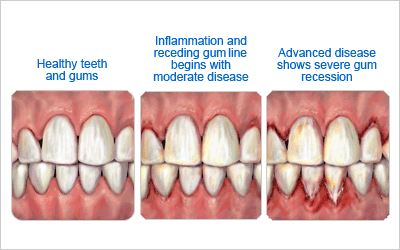
|
How Does Periodontal Disease Develop The word Periodontal means “around the tooth.” Healthy gum tissue fits like a cuff around the each tooth, protecting both the tooth and the bone below. Where the gum line meets the tooth, it forms a slight v-shaped crevice called a sulcus. In healthy teeth, this sulcus space is usually 3 millimeters or less (the depth that toothbrush bristles can easily penetrate and keep clean). |

|
Periodontal Diseases are infections that affect the gum tissue and bone that support the teeth. As the tissues are damaged, the sulcus develops into a larger and deeper pocket around the tooth that is deeper than 3 millimeters. Generally, the more severe the disease, the deeper the pocket depth and resulting bone loss. The enlarged pockets allow harmful bacteria to grow and multiply. Left untreated, periodontal diseases will lead to tooth loss. Healthy gum tissue fits snugly around each tooth. Gum tissue can be harmed by plaque, the sticky film of bacteria that forms on teeth. Bacteria in plaque creates toxins that irritate and break down your gum tissue. |
|
When plaque is not removed daily, it absorbs minerals naturally present in saliva. The minerals combine with plaque and form a rough hardened material called Calculus or Tartar that adheres to teeth. Once tartar sticks to teeth, only a professional cleaning in the dental office can remove it. Our hygienists use traditional scalers or an ultrasonic scaler to help remove calculus. Tartar that is not removed becomes a “plaque trap” harboring bacteria and making it more difficult to keep teeth clean. The early stage of Periodontal Disease is called Gingivitis when the gums may be red, swollen and bleed when brushing. Healthy gums do not bleed. The good news is that this early stage of periodontal disease is reversible if treated. If Gingivitis is not treated, it will lead to a more serious condition called Periodontitis. |
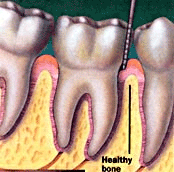
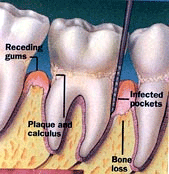
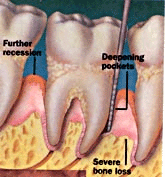
Health Gingivitis Periodontitis
| In Periodontitis, the bacterial infection of the gums causes the breakdown of the gum tissue so that it begins to pull away from the teeth and recede along the root surface, exposing the root. Instead of the gums fitting snugly around teeth, the loose gum tissue now forms pockets that collect even more bacterial plaque. With the loose area of gum tissue present, the bacteria in plaque can now infect the bone that surrounds teeth. Unless Periodontitis is treated, bone loss will result in teeth becoming loose and may require them being removed. |
|
Common Symptoms It is possible to have Periodontal Disease and have few and often painless warning signs. That’s one reason why regular dental visits and teeth cleanings are important in prevention and early diagnosis. You may notice any of these signs: -gums that bleed during brushing and flossing -red, swollen or tender gums -gums that have pulled away from your teeth exposing tooth roots -persistent bad breath -pus between your teeth and gums -loose teeth -a change in the way your teeth fit together when you bite -a change in the fit of your partial dentures Pain can occur in advanced stages or in rapidly progressing forms of Periodontal Disease. But don’t wait until it hurts. Regular visits and good oral hygiene at home can help keep your mouth healthy. |
TREATING PERIODONTAL DISEASE
|
Periodontal treatment depends of the type and severity of the disease. If caught very early when it is still Gingivitis, no permanent damage to the gum tissue and bone has been done. This stage is reversible and your teeth will be cleaned by the hygienist and you will simply be given instructions on improving your daily oral hygiene. Even with these preventive measures, the disease can progress and must be treated. All efforts by our practice focus on minimally invasive non-surgical yet effective treatment of Periodontal Disease. This early stage treatment is called Periodontal Scaling and Root Planing. This procedure involves the use of a small scaler or ultrasonic scaler with an antimicrobial solution to remove plaque and calculus (tartar) deposits on the tooth and root surfaces beyond the 3mm mark of health and on to the bottom of the periodontal pocket. After calculus removal, the root surfaces are planed, or smoothed with special curettes to prevent future bacteria and plaque from accumulating (bacteria love to attach to root surface irregularities). Special topical anesthetics are used in the gum tissue pocket to anesthetize the area before removal of calculus. After the area has been debrided or cleaned of all plaque, calculus, bacteria and its toxins, an antimicrobial solution will irrigate out the remnants of bacterial toxins from the periodontal pocket. |
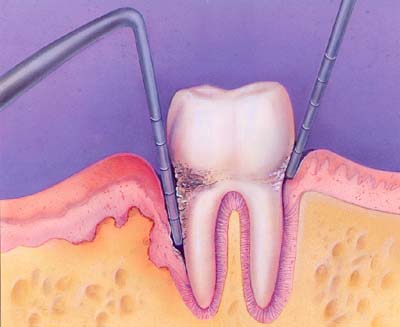
|
For more advanced treatment during Periodontal Scaling and Root Planing, localized time-released antibiotic granules may be placed into the depth of the periodontal pocket, to help stimulate the healing process and reduce the inflammation present. At your follow up visit, the pocket depth will be checked again with a periodontal probe with millimeter markings to determine the extent to which the inflammation of the gum tissue has resolved since the Periodontal Scaling and Root Planing. If the gum tissue levels have reduced back to a healthy level, an oral hygiene regimen specific to your gum tissue needs will be reinforced and regular Periodontal Maintenance Cleanings will be recommended in order to prevent relapse. These visits will focus not only on cleaning the teeth but also on reassessing and cleaning the gum tissue pockets and root surfaces to prevent regression. If Periodontal Pockets do not heal after initial treatment, LASER Periodontal Surgery may be needed to remove infected gum tissue to reduce pocket depth and make the teeth and pockets easier to clean. Bone grafts may be use to rebuild or reshape specific areas of bone around teeth destroyed by Periodontal disease. As one of the few General Dentists worldwide to be an Associate Member of the American Academy of Periodontology, Dr. Mozer and our hygienists believe that a team approach to gum tissue treatment is critical and will help select the most safe and effective method of treatment for you. |